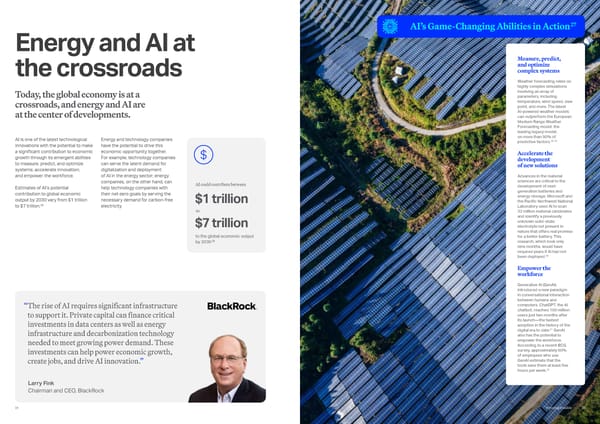“ The rise of AI requires significant infrastructure to support it. Private capital can finance critical investments in data centers as well as energy infrastructure and decarbonization technology needed to meet growing power demand. These investments can help power economic growth, create jobs, and drive AI innovation.” Larry Fink Chairman and CEO, BlackRock AI could contribute between to the global economic output by 2030 26 $1 trillion $7 trillion to AI’s Game-Changing Abilities in Action 27 20 Powering Possible 19 Measure, predict, and optimize complex systems Weather forecasting relies on highly complex simulations involving an array of parameters, including temperature, wind speed, dew point, and more. The latest AI-powered weather models can outperform the European Medium Range Weather Forecasting model, the leading legacy model, on more than 90% of predictive factors.28, 29 Accelerate the development of new solutions Advances in the material sciences are critical to the development of next- generation batteries and energy storage. Microsoft and the Pacific Northwest National Laboratory used AI to scan 32 million material candidates and identify a previously unknown solid-state electrolyte not present in nature that offers real promise for a better battery. This research, which took only nine months, would have required years if AI had not been deployed.30 Empower the workforce Generative AI (GenAI) introduced a new paradigm in conversational interaction between humans and computers. ChatGPT, the AI chatbot, reached 100 million users just two months after its launch—the fastest adoption in the history of the digital era to date.31 GenAI also has the potential to empower the workforce. According to a recent BCG survey, approximately 60% of employees who use GenAI estimate that the tools save them at least five hours per week.32 Energy and AI at the crossroads AI is one of the latest technological innovations with the potential to make a significant contribution to economic growth through its emergent abilities to measure, predict, and optimize systems; accelerate innovation; and empower the workforce. Estimates of AI’s potential contribution to global economic output by 2030 vary from $1 trillion to $7 trillion.26 Today, the global economy is at a crossroads, and energy and AI are at the center of developments. Energy and technology companies have the potential to drive this economic opportunity together. For example, technology companies can serve the latent demand for digitalization and deployment of AI in the energy sector; energy companies, on the other hand, can help technology companies with their net-zero goals by serving the necessary demand for carbon-free electricity.
 Powering Possible 2024: AI and Energy for a Sustainable Future Page 10 Page 12
Powering Possible 2024: AI and Energy for a Sustainable Future Page 10 Page 12